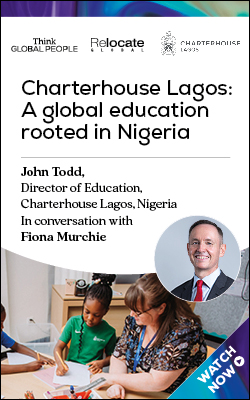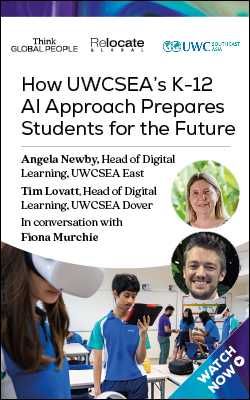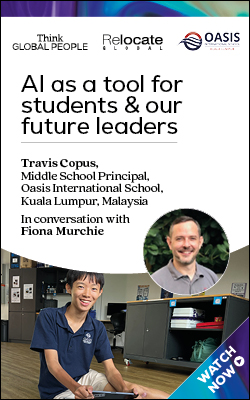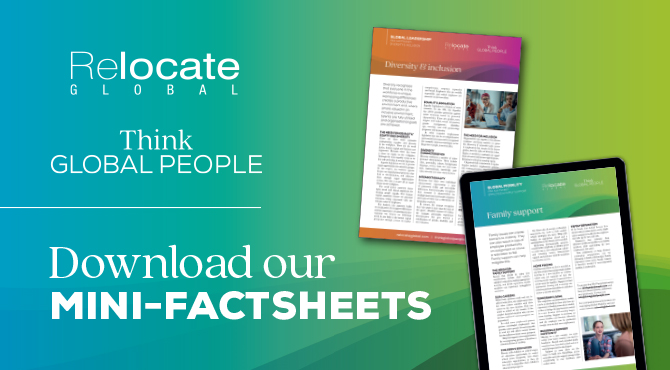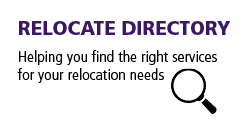Staying ahead: Future-proofing the global mobility function
The world is changing fast and the global mobility function must stay ahead and be ready to tackle new disruptors. Dr Sue Shortland reports on recent data from Air Inc. that suggests how the function can navigate this dynamic landscape.

This article is taken from the Summer 2025 issue of
Think Global People magazine
View your copy of the Summer 2025 issue of Think Global People magazine.Research by the consultancy and research firm AIRINC* suggests five ways in which global mobility professionals can future-proof their roles. These include becoming more agile, using innovative design approaches, understanding the best outcomes and use of technology, improving communications, and ensuring measurement of actions taken.
Agility within global mobility
It is important that global mobility professionals make space within their working lives and environments to pre-empt and/or respond to disruptors. Currently, the geopolitical landscape is extremely unstable with global conflicts and political shifts taking place unexpectedly. Economic instability and shocks must also be prepared for. In addition, advances in AI and emphasis being placed to a greater extent on compliance issues are important factors that the function must be ready to manage.Trends in hybrid working and the use of digital skills and remote work also require the function to stay ahead of the curve. These issues are linked into the need to attract and retain talent with the global skills required for enhanced competitiveness. The function also must respond to changing employee expectations and demographics within the workplace.Underpinning employment activities are concerns for the environment, social issues and employee health. All of these must be factored into actions taken by the global mobility function to ensure that the business is supported appropriately, employee concerns are addressed, and crises are not generated through lack of understanding and/or inaction.Issues that were once at the forefront of concern are changing. DEI is a case in point – a few years back DEI was rising rapidly up the global mobility agenda as the social aspects of relocating people around the world were becoming a key focus. With the change of presidency in the USA, this has fallen back in the list of priorities, particularly for public sector organisations in the Americas. Nonetheless, DEI still remains of high priority in other parts of the world. Global mobility professionals will need to be agile to manage the different priorities set in different countries.Global mobility professionals will need to engage their leadership in particular aspects that are of relevance and/or concern to gain their support for actions taken. It is critical to ensure that designated personnel or teams take responsibility for addressing specific challenges and for gaining an understanding of potential issues to come. In this way, the function can be agile and stay ahead of potential problems.Despite the need to be agile, Air Inc.’s research indicates that relatively few global mobility functions have agility built into their ways of working. Its research finds that only 5% of organisations describe themselves as being highly agile and able to adapt quickly to changing circumstances. Almost half of organisations either report having limited agility or a primarily reactive programme. Going forward, it is important that all global mobility functions develop greater agility to respond to challenges. Creating a SWAT team is suggested by Air Inc. as one means of addressing this.Designing new solutions
It is important that the global mobility function is creative. Rather than relying on old policies, the development of new, flexible approaches with a range of solutions available to the business is needed. The global mobility function can make good use of their partners to do this. Working creatively with others can help to leverage new solutions. For example, Air Inc. suggests getting vendors together to brainstorm issues that their clients might be facing. In this way, solutions that are specific to the business can be found.For some while now, there has been a trend towards more flexible, dynamic approaches to policy design. Relocation is a personal issue and employees today are looking for a policy that matches their personal circumstances. One single policy is no longer appropriate. We have seen a trend towards multiple policies but even these can require individuals to be "boxed up" under one heading. A more flexible approach is needed whereby using overarching guidelines, individual solutions can be created for each person or family on the move.To produce greater flexibility within the function, a more creative mind-set is needed amongst global mobility professionals. Also, any new policy guidelines produced must be marketed and communicated extremely well. Flexibility can suggest, inaccurately, a lack of equity. Effort must be made to ensure that all individuals on the move understand that tailored policy design is appropriate and works for everyone for their best interests and those of the employing organisation.Understanding new technology
The global mobility function must become more technologically aware. If it is to use flexible approaches to policy design, these will depend upon the use of appropriate technology. It will be impossible to design equitable approaches to relocation support, cost them out, and measure performance against them unless appropriate technology is used.We are hearing much about the use of AI and this is becoming a key focus within business. Yet, despite it being such a hot topic, relatively few global mobility functions appear to be actively engaging with it currently. According to Air Inc.’s statistics, over 80% of global mobility functions either never or rarely use AI in their mobility programmes. The statistics indicate only 19% either occasionally or moderately use AI – no companies use it extensively. The statistics also indicate that no global mobility functions have a detailed strategy for significantly expanding the use of AI.Given the potential of AI and the focus being placed upon it globally, global mobility functions need to consider how they can use it going forward. Air Inc. suggests that the function might use AI to answer frequently asked questions, to help develop and upload policies and to form part of the global mobility chat function. While the dangers of relying too heavily on AI must be recognised, this technology can help to improve the efficiency of the global mobility function and free up some of its time to use in more strategic activities.Read related articles
- The impact of a global shake up in the world of AI begins
- Transforming the global mobility function
- Employee relocation and assignment trends: towards flexibility and personalisation
Communicating the value of the function
There is absolutely no doubt that the global mobility function is one that adds value to the business. It has the potential to provide significant input into talent identification, management and deployment. It can also play a far more strategic role than it does currently. While there is no doubt that the value of the function in managing compliance and process issues is very high, the potential for adding further value at the strategic level must be pursued. In order to do this, the function must communicate effectively what does, how it can add value, and the benefits that can flow from its involvement. Unless global mobility professionals make an effort to communicate their strategic contribution, their role may well remain operational.The Air Inc. research suggests a wide range of impactful roles that the global mobility function can undertake. These include supporting talent growth and development through the use of global assignments as well as addressing skill shortages and filling critical roles. The talent agenda also includes helping to increase employee engagement and retention.With respect to the business itself, the global mobility function plays a key role in expansion into new markets and in building their leadership capabilities. In terms of more operational activities, its role is to mitigate compliance and legal issues involving international moves and ensure budget optimisation and cost management.In terms of communicating the wide range of activities that global mobility is involved in, and its desire to be more strategic, the function might consider a rebranding in terms of its title. Potentially it might consider itself as global talent mobility rather than simply global mobility.Air Inc. also suggests that it is important for the function to develop its own mission statement and that this should capture its strategic, advisory and operational activities. If all stakeholders can see the range of activities that the function is involved in, its worth becomes more obvious.Defining and measuring success
In order to assess its own value and for the business to recognise this, measurement is needed. Very surprisingly, the Air Inc. research indicates that over half of organisations do not have a clear definition of success against which they can measure international assignments. Only 6% of those surveyed actually had a clear and established definition.If global mobility professionals are going to show what they have achieved, they will need statistics to measure this and demonstrate value. To do this, it is important to determine what constitutes success. There could be a number of bases from which to do this – for example, employee satisfaction, employee retention, return on investment, career progression, and business impact including revenue growth. These factors can be related to individual assignments or the relocation of groups of employees. Statistics will help raise the visibility of the function and provide the basis for communication of successful outcomes.The choice of base for measurement should be made carefully. For example, using return on investment is a strategic indicator whereas measuring employee satisfaction is more operational. The global mobility function will need to determine upon which base(s) it wishes to be judged. It should use more strategic indicators if it is taking the path towards being a strategic function.Skill sets for the future
Finally it is important to consider the skills and capabilities that the global mobility function will need if it is to become an agile and valued part of the business. As organisations expand into more destinations, so the development of a global mind-set and cross-cultural capabilities are critical for members of the function.Global mobility professionals will also need to take a far more strategic approach to their work as well as gaining in-depth understanding of operational necessities such as changing compliance requirements. Understanding how best to use data and present this to their advantage is another area in which global mobility professionals must become proficient.Rather than fearing technology and AI, a new mind-set is needed to embrace it and its potential for improving the capability of the function. Members must also be receptive to change and adaptable if the function is to become more agile.Despite the overwhelming pace of change going on in today’s world, the backdrop for the global mobility function is a positive one. The function has always had to adapt and to do so quickly due to the changes across the global landscape. Global mobility professionals should not be fearful of the pace of change but excited by the opportunities that it presents to them personally and professionally and the career growth that they can each attain in the future.*Air Inc. Mobility Outlook Survey 2025. Available from:https://www.air-inc.com/wp-content/uploads/AIRINC-MOS-2025-Report-web.pdf



Find out more about the Think Global People and Think Women community and events.

Subscribe to Relocate Extra, our monthly newsletter, to get all the latest international assignments and global mobility news.Relocate’s new Global Mobility Toolkit provides free information, practical advice and support for HR, global mobility managers and global teams operating overseas.
©2025 Re:locate magazine, published by Profile Locations, Spray Hill, Hastings Road, Lamberhurst, Kent TN3 8JB. All rights reserved. This publication (or any part thereof) may not be reproduced in any form without the prior written permission of Profile Locations. Profile Locations accepts no liability for the accuracy of the contents or any opinions expressed herein.













